Ramalingam Kalirajan |6272 Answers |Ask -Follow
Mutual Funds, Financial Planning Expert - Answered on Aug 16, 2024
He has an MBA in finance from the University of Madras and is a certified financial planner.
He is the director and chief financial planner at Holistic Investment, a Chennai-based firm that offers financial planning and wealth management advice.... more
.jpg)
Hi Ma'am, I'm 32/yo aggressive investor with a homemaker wife & a 6-month-old daughter, relying on a single income 1.2L/pm Take home. Rental house. I've been investing for nearly 10 years. Current Portfolio: - a) Equity: Rs 23 lac (MF: Rs 13 lac, Stocks: Rs 11 lac) with SIP of Rs 42,000 (Nippon Large: Rs 5,000, Quant Small: Rs 5,000, Parag Parikh Flexi: Rs 10,000, ICICI Prudential: Rs 10,000, Motilal Midcap: Rs 8,000, Nippon multicap: Rs 4,000) b) Debt: Rs 24.5 lac (PPF+VPF: Rs 9.5 lac, ULIP: Rs 5 lac, Bonds: Rs 2 lac, Gold: Rs 8 lac) c) Retirement: Rs 13 lac (EPF: Rs 8.5 lac, NPS: Rs 4.5 lac) Goals: 1)Child's education 2)Building a house in Chennai 3)Rs 5 crores for retirement by age 60 4)Trying to Financial independence by age 50. Should I continue with this portfolio for the long term (15-20 years)? Pls advise.. Thank you, Bala
At 32, you have built an impressive portfolio. Your monthly income of Rs 1.2 lakh supports your family. Your investments are spread across equity, debt, and retirement funds. Your goals include securing your child’s education, building a house in Chennai, and achieving financial independence by 50. These are ambitious and achievable targets with the right strategy.
Current Portfolio Analysis
Equity Portfolio: Rs 23 lakh invested in mutual funds and stocks is well-diversified. Your SIP of Rs 42,000 is commendable, showing your commitment to wealth creation.
Debt Portfolio: Rs 24.5 lakh in PPF, VPF, ULIP, bonds, and gold provides stability. This balance between equity and debt reflects a cautious approach despite your aggressive investor profile.
Retirement Funds: Rs 13 lakh in EPF and NPS is a good foundation. Continuing contributions will help you build a substantial retirement corpus over time.
Aligning Your Portfolio with Financial Goals
Child’s Education
Education Planning: Start by estimating the future cost of education. Consider inflation. You can start a dedicated SIP in equity mutual funds. Equity funds can generate higher returns over the long term. This will help you meet the high costs of education when your child is ready for school and college.
Balanced Approach: A mix of equity and debt can be considered. Equity for growth, and debt for stability. A combination of both ensures that you are neither overexposed to market risks nor too conservative.
Building a House in Chennai
House Purchase Planning: Buying a house is a major financial decision. Set a timeline and estimate the cost. Allocate a portion of your savings towards a high-growth investment. As you near your goal, gradually shift these funds to safer debt instruments. This will protect your capital from market fluctuations.
Avoid Real Estate as an Investment: While you plan to buy a house to live in, avoid investing in real estate as a means to grow your wealth. Other investment avenues, like mutual funds, can offer better liquidity and growth.
Retirement Planning
Targeting Rs 5 Crore by Age 60: Achieving a Rs 5 crore retirement corpus by age 60 is possible with disciplined investing. Your current investments are a good start. However, increasing your SIP amount as your income grows will be crucial. This will accelerate your wealth creation.
Active Management vs. Index Funds: Avoid index funds for retirement planning. They simply track the market and lack the potential to outperform. Actively managed funds, on the other hand, have the potential to deliver higher returns, helping you reach your Rs 5 crore target more efficiently.
Financial Independence by Age 50
Aggressive Growth Strategy: To achieve financial independence by 50, you’ll need to aggressively grow your investments over the next 18 years. Focus on equity mutual funds and stocks, which can deliver higher returns. However, monitor and rebalance your portfolio regularly to manage risk.
Direct Funds vs. Regular Funds: Direct funds may seem attractive due to lower expenses, but they require active management and market knowledge. Investing through a Certified Financial Planner in regular funds ensures professional guidance. This helps you align your investments with your financial independence goal.
Portfolio Recommendations
Equity Allocation: Your current SIPs are well-diversified. However, consider reviewing the allocation to ensure they align with your goals. Increasing your SIP amount as your income grows will enhance your portfolio’s growth potential.
Debt Allocation: Continue your investments in PPF, VPF, and bonds. However, consider surrendering the ULIP and reinvesting the surrender value in mutual funds. ULIPs generally offer lower returns compared to mutual funds.
Retirement Funds: Continue your contributions to EPF and NPS. These are tax-efficient and provide a steady growth avenue for retirement.
Gold Investments: Gold is a good hedge against inflation but should not dominate your portfolio. Maintain your current allocation to gold but focus more on equity and debt for growth.
Risk Management
Insurance: Ensure you have adequate life insurance coverage. Consider a term insurance plan that provides sufficient cover for your family in case of any unforeseen events. Also, ensure you have a comprehensive health insurance plan to cover medical emergencies.
Emergency Fund: Maintain an emergency fund equivalent to 6-12 months of expenses. This ensures you are financially secure in case of income disruption.
Tax Efficiency
Tax Planning: Invest in tax-saving mutual funds to reduce your tax liability. Long-term capital gains from equity mutual funds are taxed at a lower rate, making them a tax-efficient investment.
Avoid Tax-Heavy Instruments: Steer clear of instruments that offer high returns but come with high tax implications, such as some debt instruments and FDs. Instead, focus on investments that offer better post-tax returns.
Regular Portfolio Review
Annual Portfolio Review: Review your portfolio annually with a Certified Financial Planner. Regular reviews help you stay on track towards your goals. Adjust your portfolio based on market conditions and changes in your financial situation.
Rebalancing: As you approach key milestones, like buying a house or nearing retirement, rebalance your portfolio. Shift from high-risk to low-risk investments to protect your capital.
Disadvantages of Index and Direct Funds
Index Funds: These funds merely track the market index and do not seek to outperform. Given your aggressive investment style and long-term goals, actively managed funds offer better growth potential.
Direct Funds: While direct funds have lower expense ratios, they require you to manage your investments actively. Regular funds, managed through a Certified Financial Planner, provide professional advice and help you stay aligned with your financial goals.
Final Insights
Your current portfolio is well-diversified and aligned with your aggressive investment approach. However, to achieve your financial goals—securing your child’s education, building a house, and achieving financial independence—you need to fine-tune your strategy. Increase your SIPs, focus on actively managed funds, and regularly review and rebalance your portfolio. By doing so, you’ll stay on track to achieving your financial goals with confidence.
Best Regards,
K. Ramalingam, MBA, CFP
Chief Financial Planner,
www.holisticinvestment.in
You may like to see similar questions and answers below
Omkeshwar Singh | Answer |Ask -Follow
Head, Rank MF - Answered on May 30, 2022
Ramalingam Kalirajan |6272 Answers |Ask -Follow
Mutual Funds, Financial Planning Expert - Answered on May 17, 2024
Ramalingam Kalirajan |6272 Answers |Ask -Follow
Mutual Funds, Financial Planning Expert - Answered on Jul 24, 2024
Ramalingam Kalirajan |6272 Answers |Ask -Follow
Mutual Funds, Financial Planning Expert - Answered on Jul 18, 2024
T S Khurana |91 Answers |Ask -Follow
Tax Expert - Answered on Sep 11, 2024
T S Khurana |91 Answers |Ask -Follow
Tax Expert - Answered on Sep 11, 2024
Sushil Sukhwani |543 Answers |Ask -Follow
Study Abroad Expert - Answered on Sep 11, 2024
Dr Dipankar Dutta |581 Answers |Ask -Follow
Tech Careers and Skill Development Expert - Answered on Sep 11, 2024
Dr Dipankar Dutta |581 Answers |Ask -Follow
Tech Careers and Skill Development Expert - Answered on Sep 11, 2024
Ramalingam Kalirajan |6272 Answers |Ask -Follow
Mutual Funds, Financial Planning Expert - Answered on Sep 11, 2024
Radheshyam Zanwar |839 Answers |Ask -Follow
MHT-CET, IIT-JEE, NEET-UG Expert - Answered on Sep 11, 2024
Radheshyam Zanwar |839 Answers |Ask -Follow
MHT-CET, IIT-JEE, NEET-UG Expert - Answered on Sep 11, 2024
Ramalingam Kalirajan |6272 Answers |Ask -Follow
Mutual Funds, Financial Planning Expert - Answered on Sep 11, 2024
Sushil Sukhwani |543 Answers |Ask -Follow
Study Abroad Expert - Answered on Sep 11, 2024

























